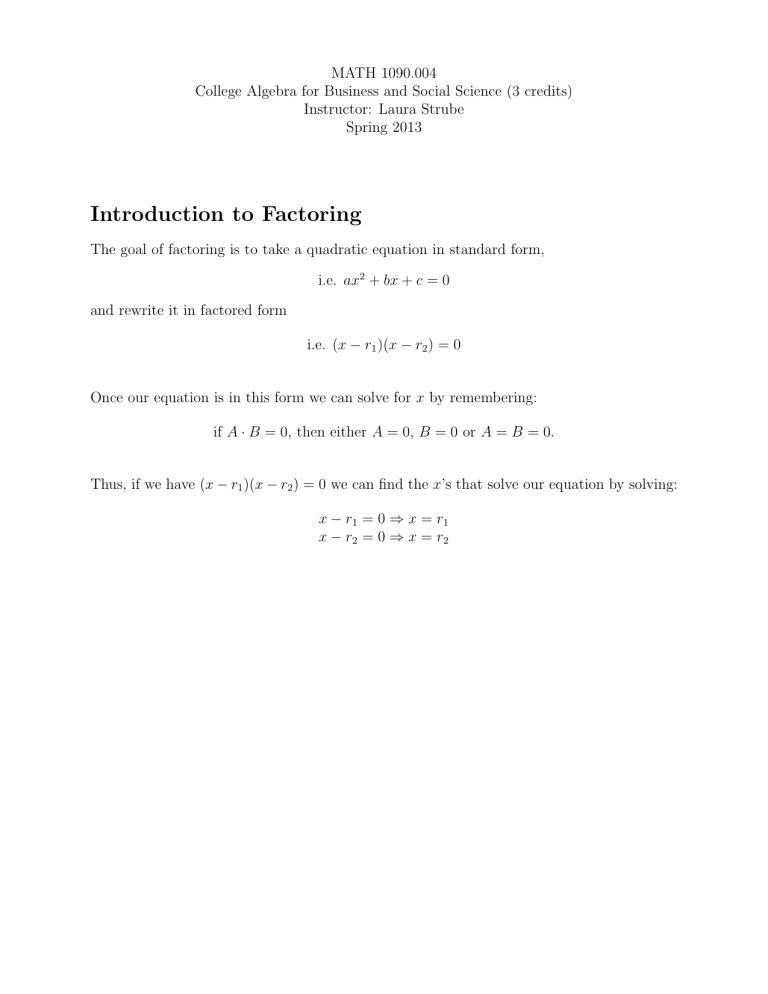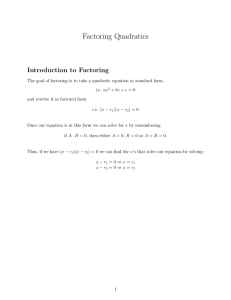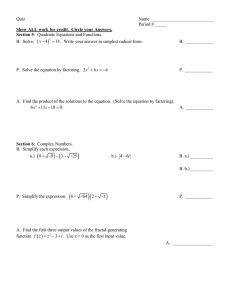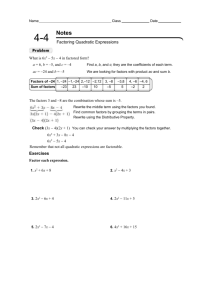MATH 1090.004 College Algebra for Business and Social Science (3 credits)

MATH 1090.004
College Algebra for Business and Social Science (3 credits)
Instructor: Laura Strube
Spring 2013
Introduction to Factoring
The goal of factoring is to take a quadratic equation in standard form, i.e.
ax 2 + bx + c = 0 and rewrite it in factored form i.e. ( x − r
1
)( x − r
2
) = 0
Once our equation is in this form we can solve for x by remembering: if A · B = 0, then either A = 0, B = 0 or A = B = 0.
Thus, if we have ( x − r
1
)( x − r
2
) = 0 we can find the x ’s that solve our equation by solving: x − r
1 x − r
2
= 0 ⇒ x = r
1
= 0 ⇒ x = r
2
Factoring: Three Cases
Case 1: Leading Coefficient is One
Example: x 2 − 11 x + 24 = 0
Compare this equation to the standard quadratic form: a = 1, b = − 11 and c = 24.
Question to ask yourself:“What two numbers multiply to equal c and add to equal b ?”
So in our case, “What two numbers multiply to equal 24 but add to equal 11? If you are able to find these numbers easily in your head that is fine - if not, you can make a table like this:
24
= (1)(24)
= (-1)(-24)
= (2)(12)
= (-2)(-12)
= (3)(8)
= (-3)(-8)
= (4)(6)
= (-4)(-6)
-11
10
-10
14
-14
11
Sum
25
-25
We choose the pair − 3 , − 8.
Remember were given: x 2 − 11 x + 24 = 0. The factored form is: ( x − 3)( x − 8) = 0.
To find the x ’s we solve the equations: x − 3 = 0 ⇒ x = 3 x − 8 = 0 ⇒ x = 8
Case 2: Leading Coefficient can be Factored Out
Example: 3 x
2 − 33 x + 72 = 0
Notice:
3 x
2 − 33 x + 72 = 3[ x
2 − 11 x + 24] = 0
Important! The “3” doesn’t disappear; it is simply “factored out”.
Now we can factor the portion of the expression in brackets exactly the way we did for case
1 to get:
3( x − 3)( x − 8) = 0
Clearly 3 = 0, thus to find the x ’s that solve our equation we solve the same pair of equations as in Case 1: x − 3 = 0 ⇒ x = 3 x − 8 = 0 ⇒ x = 8
Case 3: Leading Coefficient Cannot be Factored Out
In this case the leading coefficient is not 1, but cannot be factored out without leaving fractions behind.
Ex: 6 x 2 + 5 x − 6 = 0
Notice, if we try to factor out the 6 we get:
6[ x
2
+
5
6 x − 1] = 0
Trying to factor quadratic equations containing fractions is a pain, so instead we will use a new method.
Step 1 - Number Choice: We begin by comparing this example to the standard form equation: a = 6, b = 5, and c = − 1.
Question to ask yourself:“What two numbers multiply to equal a · c and add to equal b?
In our case: “What two numbers multiply to equal (6)( − 6) = − 36 and add to equal 5?
If you are able to find these numbers easily in your head that is fine - if not you can make a chart like the one below:
-6
= (-1)(36)
= (1)(-36)
= (-2)(18)
= (2)(-18)
= (-3)(12)
= (3)(-12)
= (-4)(9)
= (4)(-9)
= (6)(-6)
Step 2 - Rewrite your Equation :
Sum
35
-35
16
-16
9
-9
5
-5
0
Notice: 5 x = 9 x − 4 x Rewritten Equation: 6 x 2 + 9 x − 4 x − 6 = 0
Step 3 - Group the Terms:
(6 x 2 + 9 x ) + ( − 4 x − 6) = 0
Important: Always place an addition symbol between the two groups - this is still an addition/subtraction problem all you’ve done is group terms in parenthesis.
Step 4 - Common Factors:
Questions to ask yourself: (a) “What do the terms in my first group have in common?”: In our case: 3 x
(b)“What do the terms in my second group have in common?”:In our case: − 2
Step 5 - Rewrite:
(6 x
2
+ 9 x ) + ( − 4 x − 6) = 0
-is equivalent to -
3 x ( x + 3) − 2(2 x + 3) = 0
Step 6 - Apply the “Opposite” of the Distributive Property:
Notice: The terms in the paranthesis match! (If it doesn’t you did something wrong)
3 x (2 x + 3) − 2(2 x + 3) = 0 ⇒ (3 x − 2)( x + 3) = 0
Step 7 - Solve:
3 x − 2 = 0 ⇒ 3 x = 2 ⇒ x =
2
3
2 x + 3 = 0 ⇒ x = − 3
2
Now you know how to solve equations by factoring!







